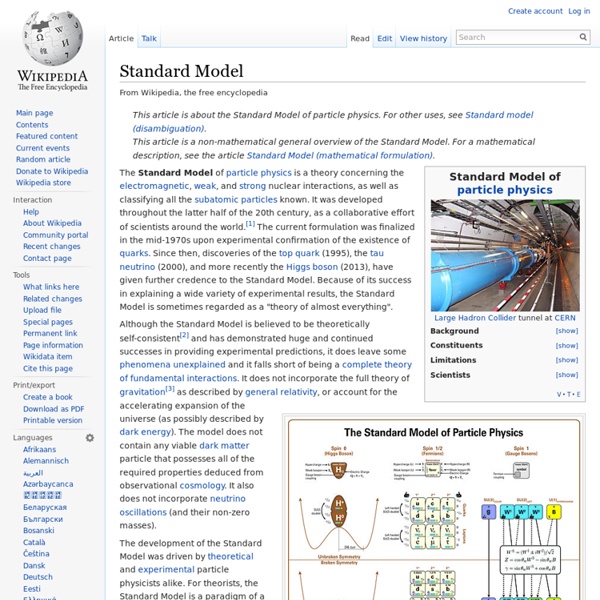Higgs boson
The Higgs boson is named after Peter Higgs, one of six physicists who, in 1964, proposed the mechanism that suggested the existence of such a particle. Although Higgs's name has come to be associated with this theory, several researchers between about 1960 and 1972 each independently developed different parts of it. In mainstream media the Higgs boson has often been called the "God particle", from a 1993 book on the topic; the nickname is strongly disliked by many physicists, including Higgs, who regard it as inappropriate sensationalism.[17][18] In 2013 two of the original researchers, Peter Higgs and François Englert, were awarded the Nobel Prize in Physics for their work and prediction[19] (Englert's co-researcher Robert Brout had died in 2011). A non-technical summary[edit] "Higgs" terminology[edit] Overview[edit] If this field did exist, this would be a monumental discovery for science and human knowledge, and is expected to open doorways to new knowledge in many fields. History[edit]
Quantum chromodynamics
In theoretical physics, quantum chromodynamics (QCD) is a theory of strong interactions, a fundamental force describing the interactions between quarks and gluons which make up hadrons such as the proton, neutron and pion. QCD is a type of quantum field theory called a non-abelian gauge theory with symmetry group SU(3). The QCD analog of electric charge is a property called 'color'. Gluons are the force carrier of the theory, like photons are for the electromagnetic force quantum electrodynamics. QCD enjoys two peculiar properties: Confinement, which means that the force between quarks does not diminish as they are separated. There is no known phase-transition line separating these two properties; confinement is dominant in low-energy scales but, as energy increases, asymptotic freedom becomes dominant. Terminology[edit] The word quark was coined by American physicist Murray Gell-Mann (b. 1929) in its present sense. History[edit] Boris Struminsky was a PhD student of Nikolay Bogolyubov.
President of Germany
The President of Germany (German: Bundespräsident)[n 1][2] is the head of state of Germany. The first presidential office in a republican Germany was created in 1919, replacing the emperor as head of state, with Friedrich Ebert (SPD) serving as the first president. The presidential standard, adopted in 1921, is still used today. While Germany had a semi-presidential system during the Weimar Republic, today's presidential office is mainly supervisory and ceremonial, with the Chancellor of Germany generally seen as wielding the effective power. The current officeholder is Joachim Gauck who was elected on 18 March 2012. Selection[edit] In total, the Federal Convention numbers more than one thousand members. Qualifications[edit] The office of president is open to all Germans who are entitled to vote in Bundestag elections and have reached the age of 40, but no one may serve more than two consecutive five-year terms. Duties and functions[edit] Appointment of the Federal Government[edit]
Electron
History[edit] In the early 1700s, Francis Hauksbee and French chemist Charles François de Fay independently discovered what they believed were two kinds of frictional electricity—one generated from rubbing glass, the other from rubbing resin. From this, Du Fay theorized that electricity consists of two electrical fluids, vitreous and resinous, that are separated by friction, and that neutralize each other when combined.[17] A decade later Benjamin Franklin proposed that electricity was not from different types of electrical fluid, but the same electrical fluid under different pressures. He gave them the modern charge nomenclature of positive and negative respectively.[18] Franklin thought of the charge carrier as being positive, but he did not correctly identify which situation was a surplus of the charge carrier, and which situation was a deficit.[19] Discovery[edit] A beam of electrons deflected in a circle by a magnetic field[25] Robert Millikan Atomic theory[edit]
Global Research
Complex analysis
Murray R. Spiegel described complex analysis as "one of the most beautiful as well as useful branches of Mathematics". Complex analysis is particularly concerned with the analytic functions of complex variables (or, more generally, meromorphic functions). Because the separate real and imaginary parts of any analytic function must satisfy Laplace's equation, complex analysis is widely applicable to two-dimensional problems in physics. History[edit] Complex analysis is one of the classical branches in mathematics with roots in the 19th century and just prior. Complex functions[edit] For any complex function, both the independent variable and the dependent variable may be separated into real and imaginary parts: and where are real-valued functions. In other words, the components of the function f(z), can be interpreted as real-valued functions of the two real variables, x and y. Holomorphic functions[edit] See also: analytic function, holomorphic sheaf and vector bundles. Major results[edit]
Electroweak interaction
In particle physics, the electroweak interaction is the unified description of two of the four known fundamental interactions of nature: electromagnetism and the weak interaction. Although these two forces appear very different at everyday low energies, the theory models them as two different aspects of the same force. Above the unification energy, on the order of 100 GeV, they would merge into a single electroweak force. Thus if the universe is hot enough (approximately 1015 K, a temperature exceeded until shortly after the Big Bang) then the electromagnetic force and weak force merge into a combined electroweak force. During the electroweak epoch, the electroweak force separated from the strong force. Formulation[edit] The pattern of weak isospin, T3, and weak hypercharge, YW, of the known elementary particles, showing electric charge, Q, along the weak mixing angle. Where θW is the weak mixing angle. Lagrangian[edit] Before electroweak symmetry breaking[edit] The where ) and , and and are
User contributions for Ancheta Wis
(newest | oldest) View (newer 50 | older 50) (20 | 50 | 100 | 250 | 500)



